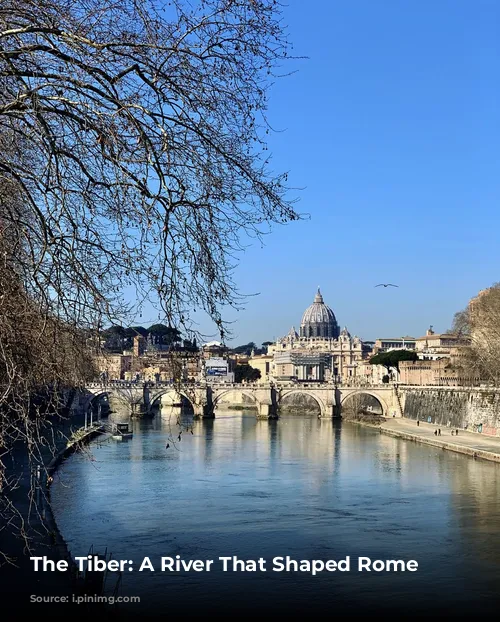Rome and its river, the Tiber, are inseparable companions. Their bond is deep, weaving through the fabric of the city’s history, culture, and present-day life. The Tiber’s story is intrinsically linked to the city’s origins, its evolution, and its enduring allure.
A River of Legends
The Tiber is more than just a waterway; it’s a living legend. The very foundation of Rome is said to have been laid on its banks. According to ancient tales, the infant twins Romulus and Remus, the founders of Rome, were abandoned in a basket on the river’s edge. The river cradled them, protecting them until a she-wolf, a symbol of Rome, nursed them back to life. This mythical story highlights the river’s role as a protector and a symbol of hope, laying the foundation for a city that would become a global powerhouse.
From Humble Beginnings to Imperial Glory
The Tiber’s influence extends beyond its mythological origins. It played a crucial role in Rome’s transformation from a small settlement to a powerful empire. Its waters provided a vital source of sustenance, transport, and trade. The river’s navigability allowed for the transportation of goods and people, contributing to the city’s economic and political growth.
Over time, the Tiber became a source of pride, reflecting Rome’s architectural grandeur. The city’s iconic monuments, from the Pantheon to the Colosseum, stand majestically along its banks. The river acts as a mirror, reflecting the city’s magnificence and inviting tourists to marvel at its timeless beauty.
An Urban Oasis
The Tiber weaves through the heart of Rome, passing by some of the city’s most beloved landmarks. It flows past Piazza Navona, a bustling square brimming with life, and the Pantheon, a breathtaking temple to all gods. The Tiber serenades the Vatican, the heart of the Catholic Church, and Saint Angel Castel, a historic fortress with a rich past. Its waters caress the Foro Boario, a historic marketplace, and Piazza del Popolo, a vibrant square. The river flows alongside Trastevere and Testaccio, charming neighborhoods that exude the soul of old Rome. These neighborhoods invite visitors to wander through ancient alleys, savor delectable meals, and enjoy the vibrant music that fills the air.
A River of Bridges, A River of Life
The Tiber is a tapestry of bridges, each with its own story to tell. The Ponte Cestio and Ponte Fabricio, standing strong after thousands of years, are testaments to the Romans’ engineering prowess. Ponte Sant’Angelo, adorned with Bernini’s angels, offers a breathtaking view of St. Peter’s Basilica, connecting the past and present. The Ponte della Musica, a modern marvel, connects the Auditorium Parco della Musica and the Maxxi with the Foro Italico Sports Compound. Ponte Milvio, a beloved meeting spot for Roman youth, has witnessed centuries of history. These bridges are not mere crossings; they are symbols of connectivity, of the enduring spirit that binds Rome’s past, present, and future.
Navigating the Tiber: A Unique Perspective
The Tiber’s waters offer a unique perspective on Rome. Boat trips along the river unveil a different side of the city, offering a chance to explore its history and beauty from a new angle. A cruise from Ponte Sant’Angelo or Ponte Marconi reveals a panoramic view of St. Peter’s Basilica. Journey further along the river to the excavations of Ostia Antica, the Port of Trajan, and the mouth of the Tiber in Fiumicino, where the river meets the sea. Discover a world of diverse flora and fauna, and marvel at the archaeological treasures that lie hidden along its shores.
A Tapestry of Nature and City Life
The Lungotevere, a long cycle path that hugs the Tiber’s banks, provides a respite from the city’s hustle and bustle. This green corridor allows visitors to explore Rome at a leisurely pace, without traffic and noise. It’s a haven for cyclists, runners, and walkers, a place to reconnect with nature. The Lungotevere offers easy access to the Foro Italico and Rome’s lush parks, providing a welcome escape from the city’s urban heartbeat. Villa Doria Pamphilj, Villa Ada Savoia, Villa Borghese, and the Baths of Caracalla offer a serene sanctuary for those seeking relaxation or a dose of fresh air.
A Timeless Legacy
The Tiber is more than just a river; it’s an integral part of Rome’s identity. Its waters have nurtured generations, carried empires, and witnessed the ebb and flow of history. The river continues to be a source of life, beauty, and inspiration, a timeless thread that binds the city’s past, present, and future.
